News
QNN Summer 2025 Newsletter
Dear QNN Group Members, Alums and Affiliates,
Happy summer everyone! We have had lots of news and comings and goings. First of all, Karl has now been in his role as EE Faculty Head for a few months and is getting used to it, finding more time to interact with the group and keeping at least one toe dipped in the research puddle lately. He also was recently honored to receive a new chair appointment, the Julius I. Stratton Chaired Professorship in Electrical Engineering and Physics, which comes from MIT’s Provost. This will also lessen the Keathley – Keithley confusion that often appeared with his previous chair 🙂!
Hope you are all doing well. If you’re ever in the area, of course come by and say hello.
Best regards,
Karl and Donnie
Comings and Goings
The last few months we’ve welcomed the following new group members:
- Giorgia Ciuffarella, Polytechnic of Turin & École Polytechnique Fédérale de Lausanne
- Gabriel LeGuay, Federal Polytechnique School of Zurich
- Davide Mondin, École Polytechnique Fédérale de Lausanne
- Hanson Nguyen, returning as an MSRP student this summer
The following members have now left and become alumni group members:
- Andi Qu, completed his UROP & graduated!
- Eric Zhan, completed his UROP
- Stephen Kandeh, Graduated with M.Eng!!
- John Simonaitis, Graduated with PhD!!
- Matthew Yeung, will be continuing Post-doc work at MIT
- Felix Ritzkowski, Continuing to work in partnership at DESI in Germany
The following members have graduated, but will be staying on in the group:
- Owen Medeiros, Graduated with PhD!!
- Alejandro Simon, Graduated with his M.S.!
Awards
- Reed Foster has received the 2025 Claude E. Shannon Award!
- DJ Paul received the Mathworks Fellowship!
- Joey Alongi received an NSF fellowship to support his work in exploring bunched electron sources in SEMs for ultrafast attosecond electron microscopy of optical and plasmonic nanostructures.
- Karl has been awarded a new chair! His new title is the Julius A. Stratton Professor in Electrical Engineering and Physics.
Theses
S. Kandeh, “ FPGA Based Data Acquisition System for Cryogenic Device Verification,” M.Eng thesis, Massachusetts Institute of Technology, 2025.
A. Simon, “Ab Initio Modeling of Superconducting Nanowire Single-Photon Detectors,” M.S. Thesis, Massachusetts Institute of Technology, 2025.
J. Simonaitis, “Low-Energy Electron Photon Interactions in a Scanning Electron Microscope,” PhD Thesis, Massachusetts Institute of Technology, 2025.
O. Medeiros, “Investigation of Thin Film Supercurrent and Photodetection in Wide Niobium Nitride Wires,” PhD Thesis, Massachusetts Institute of Technology, 2025.
- His defense can be viewed here. https://youtu.be/48O7o0BdrsM
Publications (02/01/25 – 05/31/25)
L.C. Blackburn, A. Wynn, K. K. Berggren, and N. Gershenfeld, “A Compact Bit Serial Memory Cell for Adiabatic Quantum Flux Parametron Register Files,” IEEE Transactions on Applied Superconductivity, pp. 1–5, Feb. 2025, doi: 10.1109/TASC.2025.3540048.
M. Castellani, O. Medeiros, A. Buzzi, R. A. Foster, M. Colangelo, and K. K. Berggren, “A superconducting full-wave bridge rectifier,” Nat Electron, pp. 1–9, May 2025, doi: 10.1038/s41928-025-01376-4.
A. McCarthy et al., “High-resolution long-distance depth imaging LiDAR with ultra-low timing jitter superconducting nanowire single-photon detectors,” Optica, OPTICA, vol. 12, no. 2, pp. 168–177, Feb. 2025, doi: 10.1364/OPTICA.544877.
M. Yeung et al., “Bandwidth of Lightwave-Driven Electronic Response from Metallic Nanoantennas,” Nano Lett., vol. 25, no. 13, pp. 5250–5257, Apr. 2025, doi: 10.1021/acs.nanolett.4c06536.
H.K. Warner et al., “Coherent control of a superconducting qubit using light,” Nat. Phys., vol. 21, no. 5, pp. 831–838, May 2025, doi: 10.1038/s41567-025-02812-0.
Conferences & Proceedings (02/01/25 – 05/31/25)
P.D. Keathley, “Nanoscale Petahertz Electronics for Field-Resolved Spectroscopy,” presented at CLEO, Long Beach, CA, May 2025.
K.K. Berggren, “Superconducting Nanowire Single-Photon Detectors for Quantum Sensing: From Photon-Number Resolution to Dark-Matter Detection,” presented at the Munich Conference on Quantum Science & Technology, Kufstein, Austria, Jun. 05, 2025.
S.-H. Nam et al., “Toward a portable stimulated Raman scattering system: insights from benchtop ultrafast coherent Raman studies,” in Chemical, Biological, Radiological, Nuclear, and Explosives (CBRNE) Sensing XXVI, SPIE, May 2025, pp. 70–75. doi:10.1117/12.3053483.
Preprints (02/01/25 – 05/31/25)
O. Medeiros et al., “Scalable Superconducting Nanowire Memory Array with Row-Column Addressing,” Apr. 01, 2025, arXiv: arXiv:2503.22897. doi: 10.48550/arXiv.2503.22897.
O. Medeiros et al., “Scalable Superconducting Nanowire Memory Array with Row-Column Addressing,” Apr. 01, 2025, arXiv: arXiv:2503.22897. doi: 10.48550/arXiv.2503.22897.
D.J. Paul, T. X. Zhou, and K. K. Berggren, “Determination of Mid-Infrared Refractive Indices of Superconducting Thin Films Using Fourier Transform Infrared Spectroscopy,” Feb. 28, 2025, arXiv: arXiv:2503.00169. doi: 10.48550/arXiv.2503.00169.
F. Ritzkowsky, M. Yeung, G. L. Dolso, L.-T. Chou, and P. D. Keathley, “High-Repetition Rate, CEP-stable Shortwave Infrared Source with Two-Cycle Pulses for Field-Resolved Spectroscopy,” Apr. 08, 2025, Optica Open. doi: 10.1364/opticaopen.28734833.v2.
Z. Scherübl et al., “Multimode operation of a superconducting nanowire switch in the nanosecond regime,” Feb. 25, 2025, arXiv: arXiv:2502.17980. doi: 10.48550/arXiv.2502.17980.
R. Jing et al., “Bolometric Superconducting Optical Nanoscopy (BOSON),” Apr. 20, 2025, arXiv: arXiv:2504.14547. doi: 10.48550/arXiv.2504.14547.
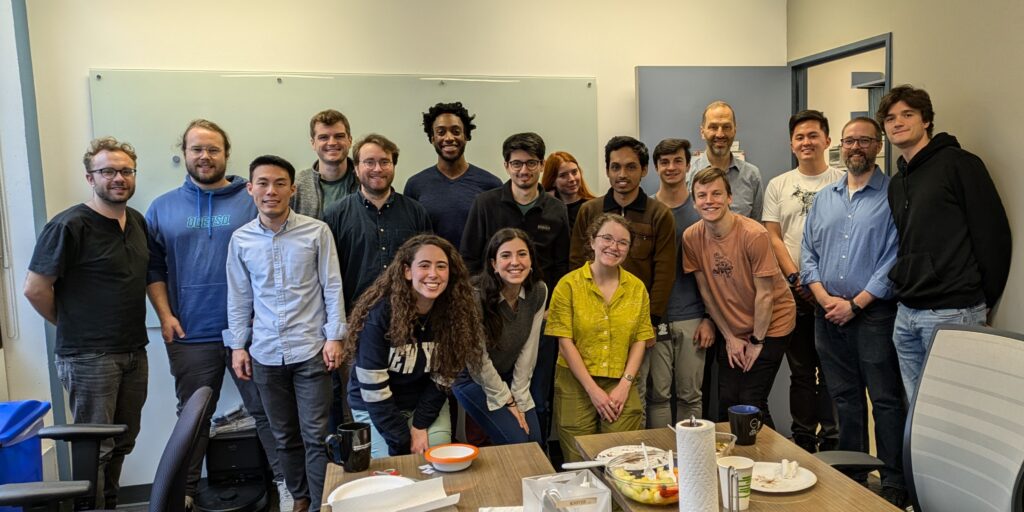
Group photo from Felix’s farewell in March. From left to right: Gian Luca Dolso, Felix Ritzkowsky, Matthew Yeung, Owen Medeiros, Ben Mazur, Adina Bechhofer, Malick Sere, Francesca Incalza, Matteo Castellani, Camron Blackburn, Emma Batson, DJ Paul, Alejandro Simon, Reed Foster, Karl K. Berggren, Andi Qu, Donnie Keathley & Joseph Alongi.
Karl K. Berggren selected as the Julius A. Stratton Professor in Electrical Engineering and Physics
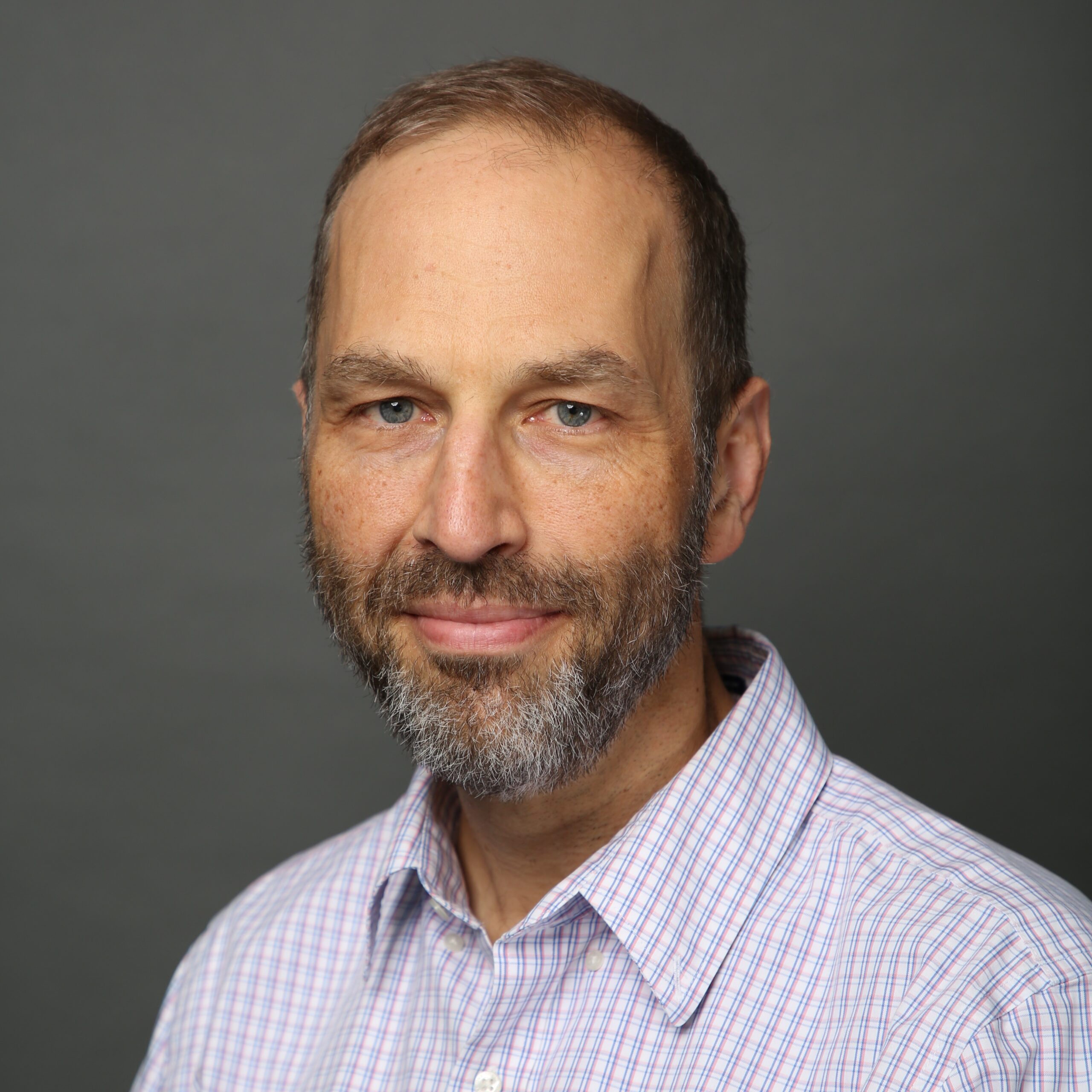
Congratulations to Karl! He has been selected as the Julius A. Stratton Professor in Electrical Engineering and Physics for a five-year renewable term beginning July 1, 2025.
This chair was established in the late 1970s by William R. Hewlett, a founder of the Hewlett-Packard Company, in honor of Prof. Stratton, the first provost and the eleventh president of MIT. Prof. Stratton had deep interests in both electrical engineering and physics; thus, the Stratton Chair is held by faculty members in EECS and Physics or those studying related fields.
Congrats to John Simonaitis and Owen Medeiros on their successful Theses Defenses!
In May 2025, we congratulates Drs. John Simonaitis and Dr. Owen Medeiros on their thesis defenses!
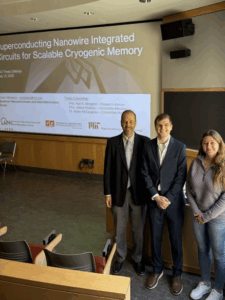
Owen Medeiros successfully defended his PhD thesis entitled “Superconducting Nanowire Integrated Circuits for Scalable Cryogenic Memory” on May 13, 2025.
The talk was recorded and can be found here.
Abstract:
Superconducting nanowire integrated circuits (SNICs) are a promising class of cryogenic electronics that harness the zero resistance, high kinetic inductance, and nanoscale geometry of ultrathin superconducting wires to implement logic, memory, amplification, and sensing with minimal energy dissipation. Unlike Josephson-junction-based circuits, SNICs support compact, planar layouts compatible with single-layer fabrication and operation in unshielded cryogenic environments.
This thesis develops superconducting nanowire memory (SNM) as a scalable implementation of SNICs. A modular cell architecture is introduced, exploiting hysteretic switching and inductive asymmetry to enable nonvolatile digital state storage with zero static power consumption. A hierarchical design framework is established, combining automated layout generation, electrothermal simulation in LTspice, and microscopic modeling using the time-dependent Ginzburg–Landau (TDGL) formalism.
John Simonaitis successfully defended his PhD thesis entitled “Low-energy Electron-Photon Interactions in a Scanning Electron Microscope” on May 12, 2025.
Abstract:
The interaction of free-electrons with matter and light is among the most fundamental of processes in nature. From the use of free-electrons for atomic imaging, to their use in the generation of high-intensity, tunable light in synchrotrons, the physics of unconfined electrons has wide application. In recent years, there has been a new focus on looking more closely at the quantum nature of individual electrons in electron microscopes to enable further improvements in these technologies. This work takes advantage of developments in ultrafast optics, electron spectroscopy, quantum optics, and nanofabrication to explore various electron-electron, electron-photon, and electron-material interactions. In this thesis, we construct a low-energy, ultrafast scanning electron microscope, using it to explore quantum coherent interactions between electrons, light, and matter.
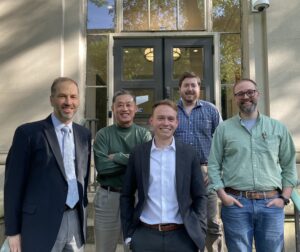
New Publication: Bandwidth of Lightwave-Driven Electronic Response from Metallic Nanoantennas
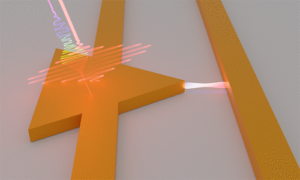
A new publication written by the group was just published in Nano Letters.
Matthew Yeung, Lu-Ting Chou, Felix Ritzkowsky, Marco Turchetti, Karl K. Berggren, Shih-Hsuan Chih, Philip D. Keathley, “: Bandwidth of Lightwave-Driven Electronic Response from Metallic Nanoantennas,” Nano Letters, 25, 13, pp. 5250–525, May 2025.
Abstract
Lightwave electronics offer transformative field-level precision and control at high optical frequencies. While recent advances show that lightwave-driven electron emission from nanoantennas enables time-domain, field-resolved analysis of optical waveforms through a small-signal analysis, the effect of the gate waveform on the measurement transfer function remains unexplored. By generating electrons with a 10-cycle pulse in the optical tunneling regime and perturbing the response with a 1.5-cycle pulse, we experimentally measure the bandwidth limitations imposed by the electron emission process. By comparing these measurements with TDSE simulations and analytical models, we reveal the temporal properties of the electronic response and its impact on the small-signal transfer function. Our results test and confirm the accuracy of the Fowler–Nordheim model in estimating the lightwave electronic response from noble metals. We envision extending these techniques to multi-octave-spanning signals for precise characterization of sub-cycle electronic responses through harmonic frequency mixing.
New Publication: A superconducting full-wave bridge rectifier

A new publication written by the group on a superconducting diode was just published in Nature Electronics.
Matteo Castellani, Owen Medeiros, Alessandro Buzzi, Reed A. Foster, Marco Colangelo and Karl K. Berggren.
M. Castellani, O. Medeiros, A. Buzzi, R. A. Foster, M. Colangelo, and K. K. Berggren, “A superconducting full-wave bridge rectifier,” Nat Electron, pp. 1–9, May 2025.
Abstract
Superconducting thin-film electronics can offer low power consumption, fast operating speeds and interfacing capabilities with cryogenic systems such as single-photon detector arrays and quantum computing devices. However, the lack of a reliable superconducting two-terminal asymmetric device, analogous to a semiconducting diode, limits the development of power-handling circuits, which are fundamental for scaling up such technology. Here we report a robust superconducting diode with tunable polarity using the asymmetric vortex surface barrier in niobium nitride micro-bridges. The diode offers a 43% peak rectification efficiency and half-wave rectification up to 120 MHz. We also integrate several of the diodes to create a bridge rectifier circuit on a single microchip that can perform continuous full-wave rectification at up to 3 MHz and alternating to direct current conversion of a 50 MHz signal in periodic bursts with an estimated peak power efficiency of 50%.